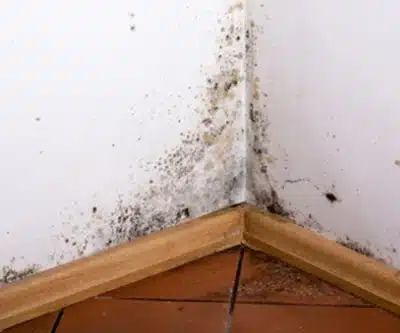Potential allergens such as pollen, mould spores and dust mite are commonplace in the daily environment and are found both inside and outside the home. Although most individuals are exposed to these allergens on a regular basis with little impact on health, regular exposure to some allergens, particularly indoor moulds can cause severe health problems, especially when present in large quantities.
Fungi, or moulds, are an abundant group of micro-organisms that play a crucial role in the degradation process of organic matter and organisms in the environment. Approximately one quarter of the Earth’s biomass is made up of fungi and approximately 100,000 species of fungi have been identified. Although moulds are fully functional in the outside environment, they can potentially pose a significant threat to health when transferred into the home.
How do moulds enter the home?
High numbers of microscopic airborne fungal spores are naturally found in outdoor air all year round and readily enter indoor environments through open windows and doors, vents and air conditioning systems. They are also brought into people’s homes via clothing, bags, shoes and household pets. As a result, most moulds found inside the home e.g. Aspergillus and Penicillium are usually comprised of both outdoor and indoor fungal spores which can be found in the soil of houseplants, dust, pets and household surfaces.
Once inside the home, fungal spores settle in a number of areas favorable to mould growth. Areas which provide warmth, moisture, a high level of humidity and a continual supply of organic matter and dirt, such as the bathroom and kitchen are prime locations. Activities such as drying laundry on indoor clothes driers or tumble dryers which are not vented to the outside can increase humidity levels in the home, consequently encouraging mould growth in the home. In addition, water damaged carpets, ceilings and walls in the home are prime sites for new growth if they are untreated and continue to remain damp. Damp housing is a common problem across the globe, especially in areas of high humidity and is heavily associated with the presence of mould in the home, as well as an increase in the incidence of health problems.
How do household moulds cause health problems?
Not all household moulds cause health problems. However, some mould spores contain allergens, irritants and produce toxins which can cause health problems, especially when ingested or inhaled deep into the respiratory tract.
What health problems are related to household moulds?
Evidence to support a relationship between the presence of household mould or damp and an increase in the incidence of health a problem such as fungal infections, respiratory illness, asthma and allergies is heavily documented.
Individuals with impaired immune functions such as the elderly, young children, cancer and HIV patients and patients who have received transplant organs are particularly susceptible to health problems caused by mould. As more and more of these patients are treated and rehabilitated in the home, it is increasingly important to ensure that secondary illnesses, such as those caused by mould exposure are prevented in these individuals.
Respiratory Tract Disorders
Scientific studies have found that more than 80 species of fungi have been associated with respiratory tract disorders, where breathing in mould can cause bronchitis, asthma, sinusitis and recurrent respiratory infections.
- Children, especially pre-school children exposed to mould have a significant increase in the risk of persistent cough and show significantly more episodes of common cold than children who are not exposed to mould. In addition, children living in damp homes display a 20-25% increase in upper respiratory tract symptoms such as coughing, wheezing and breathing difficulties.
- Studies have shown that adults living in damp homes or homes with high levels of mould report an increased incidence of respiratory infections and symptoms such as rhinitis, sore throat, cough and common cold.
- A strong correlation between high levels of mould in the home and the incidence of a Lower Respiratory Tract Infection (LRTI) diagnosis e.g. pneumonia, bronchitis, croup or bronchiolitis in the first year of a child’s life has been reported. Airborne Penicillium was shown to be significantly associated with lower respiratory infection with children aged 12 months and under.
- Scientific evidence has shown that asthma is more prevalent among adults living in damp homes and that asthma is three times more common in adults with mould allergy.
Allergic Rhinitis
Fungal spores are generally recognized as important causes of respiratory allergies in both the lower and upper respiratory tracts, causing symptoms such as sneezing, runny nose, red eyes and skin rash. The household moulds Penicillium and Aspergillus are more closely associated with allergic symptoms and allergic sensation than the common outdoor moulds.
- Research has shown that while asthma, allergies and respiratory problems are all significantly associated with indoor exposure to fungal spores, Penicillium is a risk factor for asthma and Aspergillus is a risk factor for atopy.
- A study has established a link between incidence of allergies in atopic individuals and the presence of Aspergillus fumigatus, a fungus commonly found in the soil of potted plants in the home.
Fungal Infections
Fungal infections such as Aspergillosis and Candidosis are caused by opportunistic fungi which enter the body via open wounds, or grow on the body surface, e.g. feet, skin, hair and nails. Fungal infections are highly contagious and are easily spread by direct contact. Individuals with weakened immune systems are particularly susceptible to fungal infections, where the infection can reach internal organs and become potentially life threatening.
Several studies have shown that the removal of visible mould or removal of people from exposure to mould significantly reduces or ceases the symptoms of these health problems. As such, mould must be effectively eradicated from the home, as well as prevented from entering the home in order to prevent and reduce illness.
How can I remove mould in my home?
You can help remove mould from the home in a number of ways, including controlling the level of moisture in the home, using targeted cleaning service and disinfection of household surfaces and areas prone to mould and preventing mould from entering the home.19 As mould and bacteria can co-exist on a number of surfaces, it is especially important to use a cleanser that will remove both microbes.
Controlling moisture levels in the home
- Keep humidity levels in the home as low as possible (within 30-50% humidity) to discourage mould growth.
- Regularly clean and dry damp areas of the home such as plumbing and flooring under sinks, around toilets, taps and showers using a mould and mildew cleanser that also contains an antibacterial agent.
- Keep refrigerators clean and mould free by cleaning regularly with a mould and mildew cleanser that also contains an antibacterial agent, taking care that food is not contaminated and that shelves and surfaces are thoroughly rinsed with clean water and dried properly.
- Dry water damaged areas within 24 hours, using a trained certified restoration specialist if flooding occurs and replacing wet drywall to eliminate mould growth
- Check heating and air conditioning systems for standing moisture and clean or replace as necessary.
- Regularly clean household floors and worktops/surfaces with a mould and mildew cleanser that also kills bacteria to remove fungal spores and areas of visible/invisible mould
- Regularly clean ‘mould prone’ sites of the home such as bathroom seals, sink splash backs, window seals and tiles to discourage mould growth
- Disinfect the rubbish bin/garbage can on a weekly basis and use disposable liners
- Inspect and clean food storage areas on a weekly basis for visible mould
- Launder rugs and vacuum upholstery (sofas, blinds and curtains) at least twice a month to remove mould spores
- Dry the bath, shower and shower curtain after use and replace mildewed shower curtains to prevent mould growth
Effective cleaning of household areas and surfaces prone to mould
- Regularly clean household floors and worktops/surfaces with a mold and mildew cleanser that also kills bacteria to remove fungal spores and areas of visible/invisible mold
- Regularly clean ‘mold prone’ sites of the home such as bathroom seals sink splash backs, window seals, and tiles to discourage mold growth
- Disinfect the rubbish bin/garbage can on a weekly basis and use disposable liners
- Inspect and clean food storage areas on a weekly basis for visible mold
- Launder rugs and vacuum upholstery (sofas, blinds, and curtains) at least twice a month to remove mold spores
- Dry the bath, shower, and shower curtain after use and replace mildewed shower curtains to prevent mold growth
How to restrict mold from entering the home
- Place entry mats at each doorway to restrict mould-contaminated soil and debris.
- Eliminate or reduce areas in the home inhabited by houseplants or pets to lower levels of household mold.
- Inspect all building materials or furniture entering the home for the presence of mold.
- Install air cleaning and filtration systems in the home to ensure mold spores are filtered out from the air inside the home.










